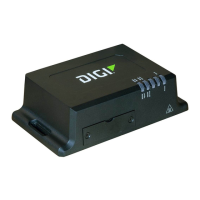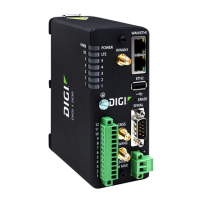Configure network interfaces Configure ISDN interfaces
Digi TransPort WR Routers User Guide 251
Configure ISDN to answer V.120 calls
V.120 is a protocol designed to provide high-speed point-to-point communication over ISDN. It
provides rate adaptation and can optionally provide error control. Both the calling and called
routers must be configured to use V.120 before data can be transferred. Similarly, if one router is
configured to use the error control facility, the other must be configured in the same way.
Initial setup
Before using V.120 you must first bind one of the two available V.120 instances to the required ASY
port using the Configuration > Network > Interfaces > Serial > Protocol Bindings page or by using
the bind command from the command line, for example:
bind v120 0 asy 0
You should also select the appropriate method of flow control for the ASY port using the
Configuration > Network > Interfaces > Serial > Serial Port n page or by using the AT&K
command from the command line. Other ASY port options such as command echo, result code
format, etc. should also be configured as necessary.
Initiating a V.120 call
Once the initial configuration is complete, V.120 calls may be initiated using the appropriate ATD
command. For example:
atd01234567890
A successful connection will be indicated by a CONNECT result code being issued to the ASY port
and the router will switch into on-line mode. In this mode, all data from the terminal attached to the
bound ASY port will be passed transparently through the router across the ISDN network to the
remote system. Similarly, all data from the remote system will be passed directly to the terminal
attached to the bound ASY port.
If a V.120 call fails the router will issue the NO ANSWER or NO CARRIER result code to the ASY port
and remain in command mode.
You can use the ATD command to route a call to an ISDN sub-address by following the telephone
number with the letter S and the required sub-address value. For example:
atd01234567890s003
In this case, the remote system only answers the call if it was configured to accept incoming calls on
the specified sub-address.

